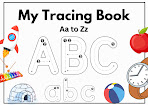FREE Alphabet Tracing Practice for Kids: Building a Strong Foundation for Language Development
The Importance of Alphabet Tracing Practice for Kids: Building a Strong Foundation for Language Development
Introduction
In the early stages of a child's education, learning the alphabet is a fundamental step in language development. It forms the basis for reading, writing, and effective communication skills. While there are various methods to teach the alphabet, one effective technique that aids in the development of fine motor skills and letter recognition is alphabet tracing. This article explores the importance of alphabet tracing practice for kids and how it can contribute to their overall educational growth.
1. Enhancing Fine Motor Skills
Alphabet tracing involves the use of a pencil or finger to follow the contours of each letter, encouraging the development of fine motor skills. This activity requires precise control of hand movements and coordination between the eyes and hands. By repeatedly tracing the alphabet, children strengthen their hand muscles and improve their hand-eye coordination, which is crucial for tasks such as writing, drawing, and using tools later on in life.
2. Letter Recognition and Formation
Tracing the alphabet allows children to become familiar with the shapes, curves, and lines that make up each letter. It helps them recognize and differentiate one letter from another, laying the foundation for future reading and writing skills. Through tracing, children gain a visual memory of each letter's form and its corresponding sound. This process aids in their ability to identify letters when they encounter them in words, leading to increased reading fluency and comprehension.
3. Reinforcing Proper Letter Formation
Alphabet tracing also helps children develop proper letter formation habits. By following the guided lines, children learn the correct starting points and stroke sequences for each letter. Consistently tracing the alphabet allows them to internalize these patterns, leading to the formation of letters that are neat, legible, and easily recognizable. This skill is essential for effective written communication and prevents confusion when reading others' handwriting.
4. Building Confidence and Motivation
Engaging in alphabet tracing activities provides children with a sense of achievement as they gradually master each letter. As they successfully trace letters, children gain confidence in their abilities, leading to a positive attitude towards learning. This motivation encourages them to explore further, helping them develop a lifelong love for reading and writing.
5. Multisensory Learning Experience
Alphabet tracing can be enriched with various multisensory elements, such as using textured surfaces, incorporating visual aids, or combining tracing with verbal repetition. These multisensory experiences engage different senses, making the learning process more interactive and enjoyable for children. By utilizing multiple senses simultaneously, alphabet tracing stimulates different areas of the brain, enhancing memory retention and overall cognitive development.
6. Preparation for Handwriting Skills
Effective handwriting skills are built upon a foundation of tracing letters. Alphabet tracing prepares children for future handwriting practice by allowing them to become familiar with the movements required for letter formation. As children progress from tracing to independent writing, they can apply the skills they acquired through tracing, resulting in legible and efficient handwriting.
Conclusion
Alphabet tracing practice is a valuable tool for children's language development, fine motor skill enhancement, and letter recognition. By engaging in this activity, children gain the necessary skills to read, write, and communicate effectively. Alphabet tracing fosters confidence, motivation, and proper letter formation habits, while providing a multisensory learning experience. As parents and educators, it is important to incorporate alphabet tracing into a child's early learning journey to establish a strong foundation for their future academic success.
About this Resource Set:
Includes Three Sets
1- PDF File - Best for Colored Printing
2- PDF File - Good for both Colored and Black & White Printing
3- PDF File - Best for Black & White Printing.
Help your child/students master writing letters with these tracing and print Alphabet Handwriting Practice Worksheets.
This set includes Handwriting/Tracing Practice and short Vocabulary for each letter of the alphabet.
A boldface representation of the letter is also provided with numbered arrows to demonstrate each step of the proper handwriting formation. Additionally, dashed representations of each letter are given for students to begin with tracing the letters as they acquaint themselves with proper letter formation. Students then move to independently writing letters on the provided lines.
These alphabet handwriting practice pages are perfect for independent practice, small group instruction, centers, early finisher activities or homework. An easy-to-use, NO PREP, option for working on writing letters and handwriting skills.
Alphabet Handwriting Practice - Writing Letters Tracing and Print Worksheets includes:
- 52 alphabet handwriting practice worksheets (One Set Colored and the Other Black and White)
- 26 half-page letter writing pages - one for each letter
- Full page includes a picture to represent the letter sound
- Simple letter formation directions included
Suggestions for Use:
Dedicate a portion of your weekly classroom instruction to letter formation. Teach one letter at a time. On the first day, introduce the letter and the steps for creating the featured letter. Students can draw the letter in the air, create the letter using play-dough, write the letter on whiteboards... the sky is the limit. After students have had a day (or longer) to explore proper letter formation, revisit the letter and teach them how to create it on lined paper. Each page in this packet includes detailed directions for how to create the letters of the alphabet. Recite these steps orally while you demonstrate the motions and encourage students to recite the steps while they work.
DOWNLOAD THIS WONDERFUL RESOURCE FOR FREE !!
PDF FILE-1 (Best for Colored Printing)
PDF FILE-2 (Best for Both Colored +B/W Printing)
PDF FILE-3 (Best for Black&White Printing)
Follow us to get more useful resources daily.
Facebook@dailycrafts.artwork
Youtube@teacherscrafts.artwork






Comments
Post a Comment